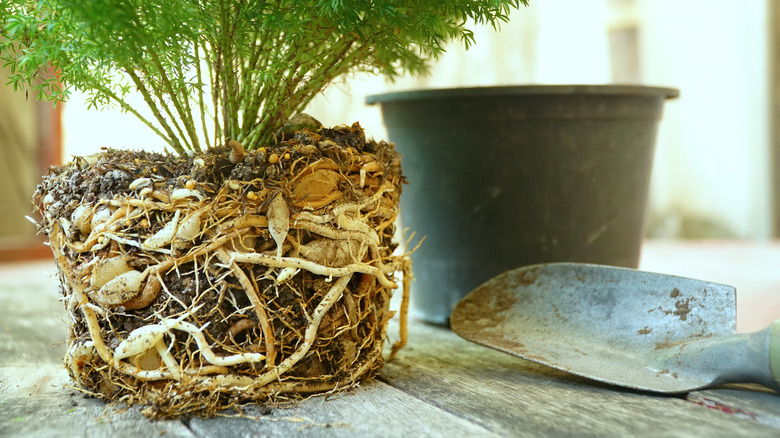This Is The Perfect Houseplant If You Struggle To Keep Your Plants Alive
Do plants often struggle to stay alive under your care? For those who love the idea of a green, thriving indoor space but cannot seem to keep up with the delicate balance required to care for plants, there's an ideal solution: the foxtail fern. Scientifically known as Asparagus densiflorus "Myers," this South African native plant is a forgiving, resilient, and visually stunning option for both seasoned gardeners and those notorious for their not-so-green thumbs.
Despite its name, the foxtail fern is not a true fern. It's actually a member of the asparagus family, though you won't get any asparagus veggies from it. This plant gets its name from its bushy, tail-looking fronds that resemble a fox's tail. These soft, needle-covered leaves grow in a plume-like pattern, creating a lush appearance. It's this unique sculptural growing pattern that makes the foxtail fern so fascinating and attractive. It can reach up to 30 inches in height and can spread up to four feet at maturity. The plant can also live up to 15 years.
One of the most compelling reasons to choose the perennial, evergreen foxtail fern is its resilience. These plants are incredibly tolerant of a variety of conditions and are particularly forgiving when it comes to the occasional neglect. They can withstand less-than-ideal lighting conditions, irregular watering, and fluctuating temperatures, all of which are common in indoor environments. So, if you're often guilty of those things when it comes to your houseplants, the foxtail fern is right up your alley.
Sun, water, and soil for your foxtail fern
Foxtail ferns thrive in bright, indirect light but can also adapt to lower light conditions. They're perfect for rooms that don't get constant sunlight throughout the day. A south-facing or west-facing window is typically ideal, providing enough light without the harsh midday sun. Another advantage of the foxtail fern is its adaptability to a range of temperatures. It's hardy in USDA zones 9 through 11 and can survive in temperatures as low as 20 degrees Fahrenheit. But to make your foxtail fern truly happy, house it between 60 and 70 degrees with a moderate level of humidity.
Overwatering or underwatering is a common problem for many houseplants, but the foxtail fern is very low-maintenance in this regard — once a week is more than enough. Allowing the top few inches of soil to dry out between waterings is a good practice. This drought-resistant plant can survive periods without water, making it an excellent choice for those who occasionally forget to water their plants. Foxtail ferns prefer loamy soil that is evenly moist but well-drained. Whether the pH is acidic, alkaline, or neutral doesn't matter much.
While foxtail ferns don't require frequent fertilization, they do benefit from a balanced, water-soluble fertilizer during the growing season (spring, summer, and fall). Feeding them twice a month during this period is sufficient to keep them healthy and encourage growth. In the dormant season (winter), you can either fertilize once a month or not at all.
Potting, pruning, pests, and pet safety
Foxtail ferns only need to be repotted when they become rootbound, or you can see roots growing upwards through the soil. When you do repot, do so in the springtime before the plant starts growing again, choose a container that's slightly larger than the current one, and use a well-draining potting mix. This minimizes the stress on the plant and ensures continued growth and health.
One of the challenges with indoor plants is their susceptibility to pests and diseases. Fortunately, foxtail ferns are relatively resistant to both. However, it's always good to watch for common pests like mites and mealybugs and treat them promptly if they appear. The foxtail fern is toxic to cats and dogs and can cause skin problems and gastric upset (via ASPCA). If you have furry friends at home, it's best to keep the foxtail fern far out of reach.
Other than being exceptionally hardy, the foxtail fern is also aesthetically pleasing. It grows tiny, fragrant, white flowers in the spring, followed by red berries in the fall. Its feathery stems create a sense of zen, making it an excellent choice for any living space. Like many houseplants, foxtail ferns also improve indoor air quality by absorbing common pollutants and releasing oxygen. Whether you're a busy professional, a forgetful waterer, or just new to the world of houseplants, the foxtail fern is a low-maintenance, perfect houseplant that promises to thrive under your care.


